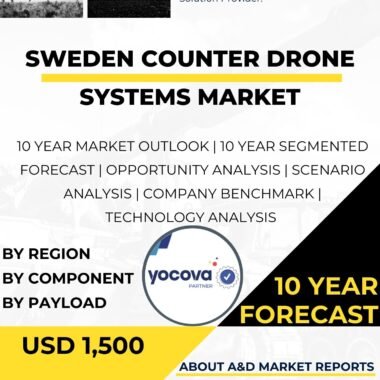Description
The South Korea counter-drone systems market is a critical and rapidly evolving segment within the nation’s defense industry. Counter-drone systems are designed to detect, track, and neutralize unauthorized drones, also known as Unmanned Aerial Vehicles (UAVs), to protect sensitive areas and critical infrastructures from potential security threats. This article provides an in-depth analysis of the current state, growth drivers, challenges, key players, and future prospects of the South Korea counter-drone systems market.
The historical context of the South Korea counter-drone systems market can be traced back to the nation’s efforts to address emerging security challenges posed by the proliferation of commercial drones. As drone technology advanced and their capabilities expanded, there was an increasing need to develop effective countermeasures to prevent unauthorized drone incursions and protect national security.
In the current landscape, the South Korea counter-drone systems market has witnessed significant growth and diversification. It encompasses a wide range of counter-drone technologies, including radar systems, electro-optical sensors, jamming devices, and kinetic solutions.
One of the primary growth drivers for the South Korea counter-drone systems market is the increasing use of drones in various applications, both for commercial and recreational purposes. With drones becoming more accessible and affordable, the potential for their misuse or unintended interference has risen, necessitating robust counter-drone solutions.
Moreover, South Korea’s strategic location in Northeast Asia and the persistence of regional security threats underscore the importance of having effective counter-drone capabilities. Protecting sensitive areas, military bases, and critical infrastructures from drone threats is essential for safeguarding national security.
Furthermore, the South Korea counter-drone systems market benefits from the nation’s focus on indigenization and developing homegrown defense technologies. The government’s commitment to fostering domestic defense capabilities has led to increased investments in research and development, driving innovation in counter-drone technology.
Additionally, strategic collaborations with international defense suppliers have been instrumental in accessing advanced counter-drone technologies and expertise. Partnering with established global companies allows for technology transfer and enables South Korea to leverage best practices in counter-drone system development.
The South Korea counter-drone systems market also derives growth from exports to international markets. South Korean companies have gained recognition for producing reliable and high-quality counter-drone solutions, attracting demand from various countries worldwide.
However, the market also faces several challenges. One of the primary challenges is the constant need for innovation and technological advancement. As drone technology evolves rapidly, developing counter-drone systems that can effectively detect and neutralize various types of drones requires continuous research and development efforts.
Moreover, counter-drone systems must strike a balance between neutralizing unauthorized drones and minimizing the potential for collateral damage or interference with legitimate drone operations, which poses a technical challenge.
Additionally, the dynamic nature of drone threats requires counter-drone systems to be adaptable and capable of detecting new drone models and tactics effectively.
To address these challenges and ensure sustained growth, South Korea’s defense industry must prioritize research and development. Investing in advanced engineering capabilities will enable the country to develop cutting-edge counter-drone systems, maintaining a competitive edge in the global market.
Furthermore, fostering strategic collaborations with international partners can enhance technological capabilities and provide access to broader markets for South Korean counter-drone solutions. Collaborating with allied nations fosters knowledge exchange and strengthens mutual defense capabilities.
The South Korean government’s continued support for the defense industry is crucial for promoting growth in the counter-drone systems market. Financial backing for research and development initiatives, as well as procurement programs, will drive innovation and ensure the development of state-of-the-art counter-drone technologies.
Moreover, promoting a skilled workforce and providing training and education in counter-drone technology will enhance the local talent pool and create a sustainable ecosystem for the South Korea market.
In conclusion, the South Korea counter-drone systems market is a critical and rapidly evolving segment within the nation’s defense industry. Driven by the increasing use of drones and the need to protect national security, indigenizing defense technologies, and expanding export opportunities, the market continues to grow steadily. However, challenges related to innovation, global competition, and the dynamic nature of drone threats require proactive measures from the government and the defense industry to ensure sustained growth and competitiveness in the global market. By investing in research and development, fostering strategic collaborations, and promoting a skilled workforce, South Korea can strengthen its position as a key player in the global counter-drone systems market and enhance its overall defense capabilities.




